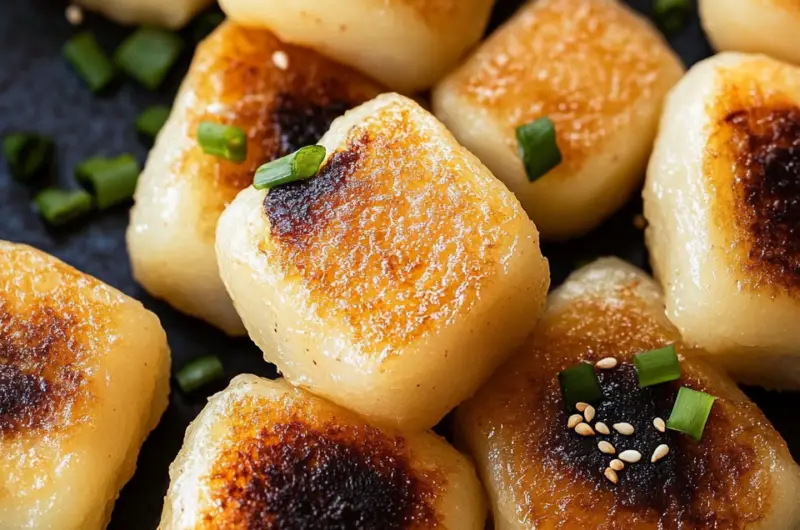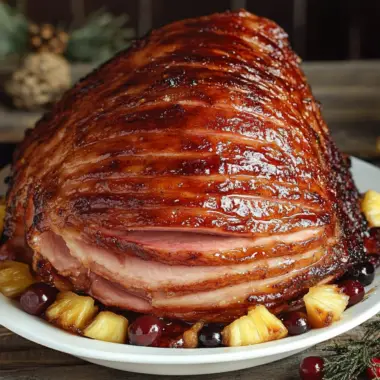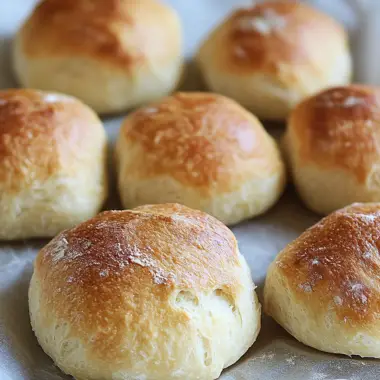The Vegan Potato Mochi recipe brings together humble ingredients with an irresistible texture and rich umami glaze. Inspired by traditional Japanese street food, this vegan-friendly version is chewy on the inside, golden-crisp on the outside, and coated in a sweet and savory soy-based glaze that makes it absolutely unforgettable. Not only is it simple to make with just a few pantry staples, but it’s also naturally gluten-free and incredibly versatile. Whether you enjoy them as an appetizer, light lunch, or party snack, these Potato Mochi are sure to impress. Try garnishing with chopped green onions or sesame seeds for extra flavor and flair. It’s the perfect comfort food that feels both indulgent and nourishing.
Full Recipe:
Ingredients:
-
3 medium floury potatoes (e.g., Russet), peeled and cubed
-
1/2 cup glutinous rice flour
-
2 tablespoons soy sauce
-
1 tablespoon maple syrup
-
1 tablespoon mirin
-
1/2 teaspoon sesame oil
-
1 tablespoon neutral oil (for frying)
-
Pinch of salt
-
Chopped green onions and sesame seeds for garnish (optional)
Directions:
-
Boil the cubed potatoes until fork-tender, about 12–15 minutes. Drain and mash until smooth.
-
Once slightly cooled, stir in glutinous rice flour and a pinch of salt. Mix into a smooth, pliable dough.
-
Divide the dough into 6-8 portions and form each into a round disc, flattening slightly.
-
Heat neutral oil in a non-stick pan over medium heat. Fry the mochi discs for 3-4 minutes per side until golden brown and crispy.
-
In a small saucepan, mix soy sauce, maple syrup, mirin, and sesame oil. Heat gently until it thickens slightly.
-
Brush the cooked mochi with the glaze or toss them lightly to coat.
-
Garnish with green onions and sesame seeds if desired. Serve warm.
Prep Time: 15 minutes | Cooking Time: 20 minutes | Total Time: 35 minutes
Kcal: 168 kcal | Servings: 4 servings
A Closer Look at Potato Mochi: A Chewy, Crispy Vegan Delight
Potato Mochi is one of those comforting yet unexpected dishes that combine simple ingredients with an elevated, satisfying result. A beautiful hybrid of Japanese culinary tradition and modern plant-based creativity, this dish takes the humble potato and transforms it into a chewy, crispy, and umami-rich treat. Especially popular among fans of Japanese street food and cozy home-style snacks, vegan Potato Mochi is gaining momentum across social platforms and food blogs alike for its easy preparation, versatility, and memorable texture.
In this long-form article, we will explore the roots and rise of Potato Mochi, understand what makes it so crave-worthy, and why it’s a must-try addition to your vegan or gluten-free recipe repertoire. We’ll also dive into various ways to serve and customize this delicious dish while offering insights into its nutritional value and kitchen adaptability.
What Is Potato Mochi?
Potato Mochi is a Japanese-inspired snack made from mashed potatoes and glutinous rice flour (also known as sweet rice flour or mochiko). The dough is formed into discs and pan-fried until golden brown on the outside while remaining deliciously chewy and soft on the inside. Once cooked, it’s often glazed with a soy-based sweet-savory sauce that gives it its signature umami profile.
Traditionally, mochi is made from steamed glutinous rice that is pounded into a sticky paste and molded into various shapes. While that version is time-consuming and often reserved for special occasions, the potato-based mochi offers a simpler, more accessible approach that preserves the mochi-like chewiness while cutting down on prep time and complexity.
This plant-based version is 100% vegan and gluten-free, which makes it an inclusive option for diverse dietary preferences.
The Origins and Cultural Context of Mochi
To understand Potato Mochi, it’s helpful to appreciate the broader context of mochi in Japanese culture. Mochi has long been a symbol of prosperity, tradition, and celebration in Japan, especially during New Year festivities (Oshogatsu) and other holidays. It’s considered a food of good fortune and often appears in soups, sweets, and savory dishes.
With the global expansion of Japanese cuisine and increased experimentation among home cooks and chefs, mochi has evolved into many unique forms mochi donuts, mochi waffles, and now Potato Mochi. This reinterpretation marries traditional techniques with global pantry staples, giving birth to a fusion snack that feels familiar yet novel.
Potato Mochi in particular rose in popularity after appearing in pop culture (like in the Nintendo game Pokémon Legends: Arceus), leading to a surge in interest from foodies and gamers alike. While that version includes ingredients like soy sauce and mirin, vegan food bloggers have embraced and reimagined the dish, turning it into a highly shareable and Instagram-worthy treat.
Why Potato Mochi Is So Popular
Several reasons contribute to the soaring popularity of Potato Mochi, especially in the vegan and gluten-free communities:
1. Unique Texture
One of the standout qualities of Potato Mochi is its irresistibly chewy texture. The combination of mashed potatoes and glutinous rice flour produces a sticky dough that crisps up beautifully on the outside while remaining soft and elastic inside. This contrast creates a tactile eating experience rarely found in everyday potato recipes.
2. Flavor Versatility
The flavor profile of Potato Mochi is incredibly flexible. While the classic preparation features a sweet-savory soy glaze, you can switch things up by using spicy sauces, creamy vegan dips, or even sweet versions (e.g., maple syrup or nut butter toppings). The potato base acts like a blank canvas, making it perfect for experimenting.
3. Quick & Easy to Prepare
With just a handful of ingredients and less than 40 minutes from start to finish, Potato Mochi is an approachable recipe for both beginner and seasoned home cooks. There’s no need for special tools or techniques just boil, mash, mix, and fry.
4. Dietary Inclusive
This dish is naturally vegan and gluten-free, making it accessible to those with dietary restrictions. It also allows easy substitutions, whether you’re reducing oil, minimizing sodium, or avoiding certain sweeteners.
5. Aesthetic Appeal
Potato Mochi is visually appealing, especially when finished with a glossy soy glaze and garnished with sesame seeds or scallions. It makes for a perfect post-worthy dish on platforms like Instagram, Pinterest, or TikTok.
Serving Suggestions and Pairings
Potato Mochi shines on its own as a snack or appetizer, but it also fits beautifully into larger meals. Here are a few ideas on how to serve and enjoy it:
-
Appetizer Platter: Serve alongside edamame, seaweed salad, or vegetable gyoza for a complete Japanese-inspired starter set.
-
Rice Bowl Topper: Add a few pieces of Potato Mochi over a bowl of steamed jasmine or sushi rice, along with sautéed greens, pickled vegetables, and a drizzle of extra glaze.
-
Snack Plate: Pair with a hot cup of green tea or miso soup for a cozy mid-day snack.
-
Brunch Option: Add Potato Mochi to your brunch table next to avocado slices, grilled tofu, or vegan scrambled eggs.
-
Street Food Vibes: Stick them on skewers, brush with glaze, and serve like yakitori-style street snacks.
Tips for Perfect Potato Mochi Every Time
To achieve the ideal balance of crispy exterior and chewy interior, consider the following tips:
-
Use the Right Potatoes: Floury varieties like Russet or Maris Piper are ideal because they break down easily when mashed and absorb the glutinous rice flour well.
-
Cool Before Mixing: Let the mashed potatoes cool slightly before adding the rice flour. This prevents the dough from becoming too sticky or hard to work with.
-
Non-Stick Pan is Key: Use a well-oiled, non-stick pan to ensure an even golden crust without sticking.
-
Don’t Overcrowd the Pan: Give each mochi disc enough space to brown evenly.
-
Brush, Don’t Soak: When glazing, brush the sauce on rather than dunking to prevent sogginess and maintain crisp edges.
Nutritional Benefits
While Potato Mochi is considered a treat or snack, it does offer some nutritional value:
-
Potatoes provide potassium, vitamin C, and fiber (especially if you keep the skins on).
-
Glutinous Rice Flour is low in fat and contains some essential minerals like zinc and magnesium.
-
Homemade Sauces let you control sodium and sugar levels, unlike store-bought glazes.
With careful ingredient choices, Potato Mochi can be a smart addition to a balanced plant-based diet.
A Dish That Sparks Creativity
Beyond the classic soy-glazed version, there are endless ways to customize your Potato Mochi experience:
-
Spicy Lovers: Add chili flakes or use a spicy Gochujang glaze.
-
Sweet Tooth: Try a maple-cinnamon topping or dip in vegan chocolate.
-
Herbaceous Twist: Mix chopped chives, cilantro, or even za’atar into the dough.
-
Stuffed Option: Insert small cubes of vegan cheese or seasoned tofu into the center before frying.
The adaptability of this dish makes it a fun playground for anyone looking to try something new in the kitchen.
Conclusion:
Potato Mochi is more than just a fun food trend it’s a wholesome, crave-worthy dish that hits all the right notes: texture, flavor, visual appeal, and ease of preparation. It brings a sense of comfort while introducing exciting new textures and flavors to your weekly menu.
Whether you’re a seasoned vegan, someone with gluten intolerance, or simply a curious foodie looking to try something new, Potato Mochi offers something delightful and satisfying. The beauty of this dish lies in its balance crispy yet chewy, savory yet subtly sweet, familiar yet exotic.








